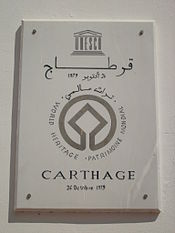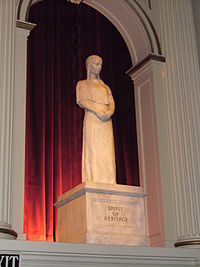- Cultural heritage
-
 Roman ruins with a prophet, by Giovanni Pannini, 1751. The artistic cultural heritage of the Roman Empire served as a foundation for later Western culture, particularly via the Renaissance and Neoclassicism (as exemplified here).
Roman ruins with a prophet, by Giovanni Pannini, 1751. The artistic cultural heritage of the Roman Empire served as a foundation for later Western culture, particularly via the Renaissance and Neoclassicism (as exemplified here).
Cultural heritage ("national heritage"[citation needed] or just "heritage") is the legacy of physical artifacts (cultural property) and intangible attributes of a group or society that are inherited from past generations, maintained in the present and bestowed for the benefit of future generations. Cultural heritage includes tangible culture (such as buildings, monuments, landscapes, books, works of art, and artifacts), intangible culture (such as folklore, traditions, language, and knowledge), and natural heritage (including culturally-significant landscapes, and biodiversity).
The deliberate act of keeping cultural heritage from the present for the future is known as Preservation (American English) or Conservation (British English), though these terms may have more specific or technical meaning in the same contexts in the other dialect.
Cultural heritage is often unique and irreplaceable, which places the responsibility of preservation on the current generation. Smaller objects such as artworks and other cultural masterpieces are collected in museums and art galleries. Grass roots organizations and political groups, such as the international body UNESCO, have been successful at gaining the necessary support to preserve the heritage of many nations for the future.
Contents
Impulse to preserve
Objects are important to the study of human history because they provide a concrete basis for ideas, and can validate them. Their preservation demonstrates a recognition of the necessity of the past and of the things that tell its story.[1] In The Past is a Foreign Country, David Lowenthal observes that preserved objects also validate memories. While digital acquisition techniques can provide a technological solution that is able to acquire the shape and the appearance of artifacts with an unprecedented precision[2] in human history, the actuality of the object, as opposed to a reproduction, draws people in and gives them a literal way of touching the past. This unfortunately poses a danger as places and things are damaged by the hands of tourists, the light required to display them, and other risks of making an object known and available. The reality of this risk reinforces the fact that all artifacts are in a constant state of chemical transformation, so that what is considered to be preserved is actually changing – it is never as it once was.[3] Similarly changing is the value each generation may place on the past and on the artifacts that link it to the past.
What is considered cultural heritage by one generation may be rejected by the next generation, only to be revived by a succeeding generation.
Types of heritage
 Classical Ruins by Hubert Robert, 1798. Elements of tangible culture depicted include the ruins of the obelisk (foreground) and the pyramids (background).
Classical Ruins by Hubert Robert, 1798. Elements of tangible culture depicted include the ruins of the obelisk (foreground) and the pyramids (background).
Cultural property
See also: material cultureCultural property includes the physical, or "tangible" cultural heritage, such as buildings and historic places, monuments, books, documents, works of art, machines, clothing, and other artifacts, that are considered worthy of preservation for the future. These include objects significant to the archaeology, architecture, science or technology of a specific culture.
Aspects and disciplines of the preservation and conservation of tangible culture include:
-
- Art conservation
- Architectural conservation
- Film preservation
- Phonograph record preservation
Intangible culture
Main article: Intangible cultural heritage"Intangible cultural heritage" consists of non-physical aspects of a particular culture, often maintained by social customs during a specific period in history. The ways and means of behavior in a society, and the often formal rules for operating in a particular cultural climate. These include social values and traditions, customs and practices, aesthetic and spiritual beliefs, artistic expression, language and other aspects of human activity. The significance of physical artifacts can be interpreted against the backdrop of socioeconomic, political, ethnic, religious and philosophical values of a particular group of people. Naturally, intangible cultural heritage is more difficult to preserve than physical objects.
Aspects of the preservation and conservation of cultural intangibles include:
Natural heritage
See also: Conservation movement"Natural heritage" is also an important part of a society's heritage, encompassing the countryside and natural environment, including flora and fauna, scientifically known as biodiversity, as well as geological elements (including mineralogical, geomorphological, paleontological, etc.), scientifically known as geodiversity. These kind of heritage sites often serve as an important component in a country's tourist industry, attracting many visitors from abroad as well as locally. Heritage can also include cultural landscapes (natural features that may have cultural attributes).
Aspects of the preservation and conservation of natural heritage include:
World heritage movement
Plaque stating the designation of Carthage as a World Heritage Site.
Significant was the Convention Concerning the Protection of World Cultural and Natural Heritage that was adopted by the General Conference of UNESCO in 1972. As of 2011, there are 936 World Heritage Sites: 725 cultural, 183 natural, and 28 mixed properties, in 153 countries. Each of these sites is considered important to the international community. In additional, UNESCO has begun designating masterpieces of the Oral and Intangible Heritage of Humanity. The Committee on Economic, Social and Cultural Rights sitting as part of the United Nations Economic and Social Council with article 15 of its Covenant had sought to instill the principles under which cultural heritage is protected as part of a basic human right.
Key international documents and bodies include:
- Athens Charter, 1931
- Roerich Pact, 1935
- Hague Convention for the Protection of Cultural Property in the Event of Armed Conflict, 1954, (with a definition of cultural heritage item adopted by some national law)
- Venice Charter, 1964
- Barcelona Charter, 2002 (regarding maritime vessel preservation)
- ICOMOS
National and regional heritage movements
Much of heritage preservation work is done at the national, regional, or local levels of society. Various national and regional regimes include:
- Heritage Conservation in Australia
- Burra Charter
- Heritage Overlay in Victoria, Australia
- Heritage conservation in Canada
- Heritage conservation in Hong Kong
- Cultural Properties of Japan
- Conservation in the United Kingdom
- Historic preservation in the United States
- National Register of Historic Places (United States)
- Heritage structures in Hyderabad
Issues in cultural heritage
Broad philosophical, technical, and political issues and dimensions of cultural heritage include:
- Cultural heritage repatriation
- Cultural Heritage Management
- Cultural property law
- Heritage tourism
- Virtual Heritage
See also
A personification of heritage as represented by a statue in The American Adventure in the World Showcase pavilion in Walt Disney World's Epcot.
- Values (heritage)
- Antiquarian
- Collecting
- Heritage film
Digital methods in preservation
- DigiCULT
- ERPANET
- Intellectual property issues in cultural heritage (IPinCH)
- MICHAEL (webportal)
References
- ^ Tanselle, G. Thomas (1998), Literature and Artifacts, Charlottesville, VA: Bibliographical Society of the University of Virginia, ISBN 1883631068, OCLC 39223648
- ^ Paolo Cignoni, Roberto Scopigno (June 2008), "Sampled 3D models for CH applications: A viable and enabling new medium or just a technological exercise?" (PDF), ACM Journal on Computing and Cultural Heritage 1 (1): 1, doi:10.1145/1367080.1367082, http://vcg.isti.cnr.it/Publications/2008/CS08/.
- ^ Lowenthal, David (1985), The Past is a Foreign Country, New York: Cambridge University Press, ISBN 0521224152, OCLC 12052097
Further reading
- Barbara T. Hoffman, Art and cultural heritage: law, policy, and practice, Cambridge University Press, 2006
- Dallen J. Timothy and Gyan P. Nyaupane, Cultural heritage and tourism in the developing world : a regional perspective, Taylor & Francis, 2009
- Peter Probst, "Osogbo and the Art of Heritage: Monuments, Deities, and Money", Indiana University Press, 2011
External links
- Cultural heritage policy - history and resources Getty Museum - list of major international cultural heritage documents, charters, and treaties
- UNESCO World Heritage Centre – Official website of the United Nations cultural heritage body
- International Council on Monuments and Sites
- International Council of Museums
- International Centre for the Study of the Preservation and Restoration of Cultural Property
- Inventory of Heritage Organisations in Europe (English, French, German and Dutch language)
- International Institute for Conservation of Historic and Artistic Works
- Cultural routes and landscapes, a common heritage of Europe (English and French language)
- EPOCH – European Research Network on Excellence in Processing Open Cultural Heritage
- Cultural heritage search engine
Categories: -
Wikimedia Foundation. 2010.




